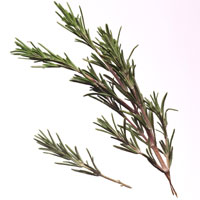Search Healthnotes
Rosemary

Preparation, Uses, & Tips
Rosemary can be used as a seasoning in a variety of dishes including fruit salads, soups, vegetables, meat (particularly lamb), fish and egg dishes, stuffings, dressings, and breads. It is excellent with tofu and potatoes, too, and is a classic Italian pizza herb, along with oregano. A half dozen fresh rosemary springs make a simple and delicious stuffing for roast chicken.
With its pinelike, camphor flavor, rosemary is more potent than most herbs, and its flavor is not subdued by cooking. Since it can be overpowering, it’s better to add too little rosemary, rather than too much. For an aromatic barbecue, add rosemary stems and sprigs to the coals just before grilling.
The leaves should be crushed or minced to bring out their full flavor before sprinkling over or rubbing onto foods. When using olive oil as a flavorful alternative to butter, try placing whole sprigs of rosemary in the oil for an herbal accent.
Rosemary goes especially well with bay leaves, chervil, chives, parsley, and thyme.
The individual blue rosemary flowers are edible and can be used in salads as a garnish.
Copyright © 2024 TraceGains, Inc. All rights reserved.
Learn more about TraceGains, the company.
The information presented in the Food Guide is for informational purposes only and was created by a team of US–registered dietitians and food experts. Consult your doctor, practitioner, and/or pharmacist for any health problem and before using any supplements, making dietary changes, or before making any changes in prescribed medications. Information expires December 2024.











